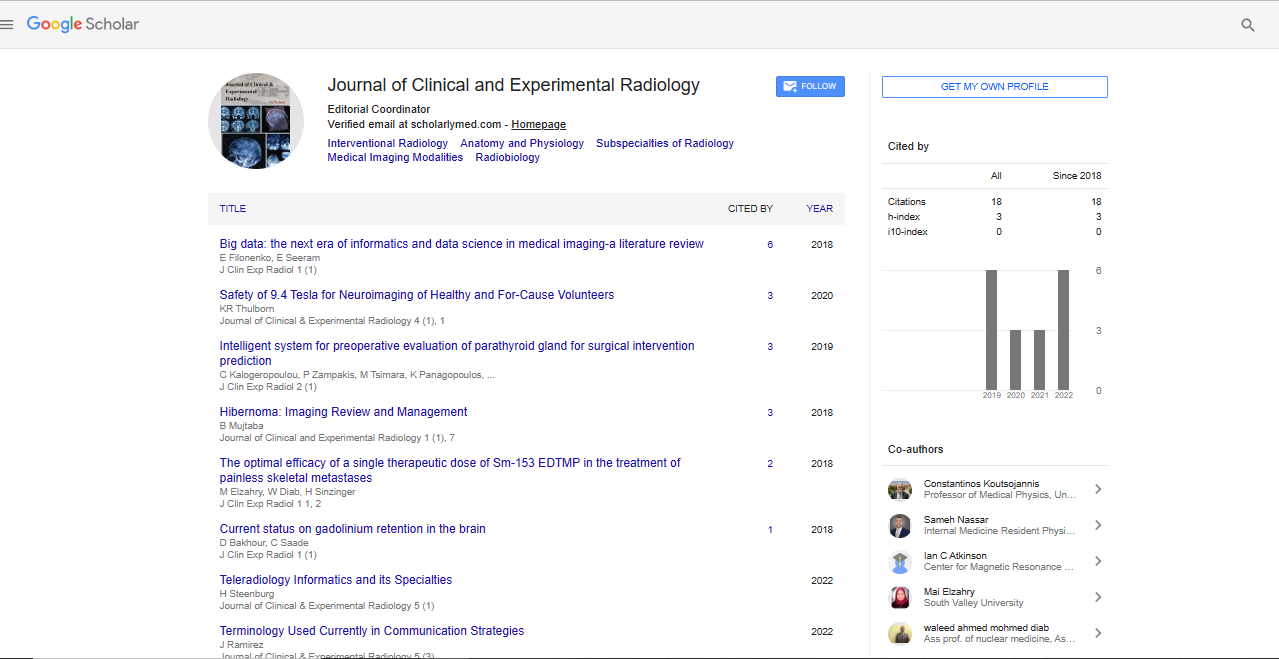Opinion Article, J Clin Exp Radiol Vol: 6 Issue: 1
A Diagnostic Radiology Technique for Evaluating spinal cord and Nerve Root
Brandon Henson*Department of Radiology, University of Michigan, Michigan, USA
*Corresponding Author: Brandon Henson
Department of Radiology
University of Michigan
Michigan, USA
Email: hensonbrandon@gmail.com
Received date: 20 February, 2023, Manuscript No. JCER-23-96022;
Editor assigned date: 22 February, 2023, PreQC No. JCER-23-96022(PQ);
Reviewed date: 08 March, 2023, QC No. JCER-23-96022;
Revised date: 15 March, 2023, Manuscript No. JCER-23-96022 (R);
Published date: 22 March, 2023, DOI: 10.4172/jcer.1000130
Citation: Henson B (2023) A Diagnostic Radiology Technique for Evaluating Spinal Cord and Nerve Root. J Clin Exp Radiol 6:1.
Description
A myelogram is a specialized diagnostic radiology technique that involves the injection of contrast dye into the spinal canal to visualize the spinal cord and nerve roots. It is commonly used to evaluate various spinal pathologies, such as herniated discs, spinal tumors, spinal stenosis, and other conditions that affect the spinal cord and nerve roots.
Technique of myelogram
Patient preparation: Before the myelogram, the patient's medical history, including any known allergies or previous adverse reactions to contrast dye, is obtained. The patient is also informed about the procedure and its potential risks. Blood tests may be performed to assess the patient's kidney function, as contrast dye is excreted through the kidneys.
Positioning and anesthesia: The patient is positioned on an X-ray table in a lateral (side) or prone (face down) position. Local anesthesia is administered at the site where the contrast dye will be injected, usually in the lower back.
Contrast injection: A small amount of contrast dye is injected into the spinal canal using a thin needle. The contrast dye helps to outline the spinal cord and nerve roots, making them visible on X-ray images.
X-ray imaging: X-ray images are taken in multiple positions to visualize the spread of the contrast dye and to identify any abnormalities, such as herniated discs or tumors. Additional images may be obtained during fluoroscopy, which is a real-time X-ray imaging technique that allows the radiologist to monitor the flow of contrast dye in real-time.
Post-procedure care: After the myelogram, the patient is monitored for any adverse reactions, such as allergic reactions or headache. The patient is instructed to drink plenty of fluids to help flush out the contrast dye from the body.
Indications for myelogram
Suspected herniated disc: Myelogram can help identify the location and extent of a herniated disc, which is a common cause of back pain and leg pain.
Spinal tumors: Myelogram can help visualize spinal tumors, including primary tumors that originate in the spine and metastatic tumors that spread from other parts of the body to the spine.
Spinal stenosis: Myelogram can be used to evaluate the narrowing of the spinal canal, known as spinal stenosis, which can cause compression of the spinal cord or nerve roots.
Nerve root compression: Myelogram can help identify nerve root compression caused by conditions such as degenerative disc disease, spondylolisthesis, or foraminal stenosis.
Traumatic spinal injuries: Myelogram can be used to assess the extent of spinal cord or nerve root injury in cases of traumatic spinal injuries, such as fractures or dislocations.
Infection: Myelogram can help identify infections of the spine, such as spinal epidural abscess or osteomyelitis.
Failed back surgery syndrome: Myelogram can be used in cases of failed back surgery syndrome, where a patient continues to experience pain after a previous spinal surgery, to identify the cause of the persistent symptoms.
Potential risks of myelogram
Allergic reactions: Some patients may develop an allergic reaction to the contrast dye used in myelogram. Allergic reactions can range from mild, such as rash or itching, to severe, and such as difficulty breathing or anaphylaxis, which is a life-threatening reaction. However, severe allergic reactions are rare.
Headache: Some patients may experience a headache after myelogram, which is usually mild and temporary. It may be caused by the contrast dye or the spinal tap, and can be managed with over-thecounter pain medications and plenty of fluids.
Infection: As with any procedure that involves needle puncture, there is a risk of infection. However, the risk of infection is low, as strict sterile techniques are followed during the procedure.
Nerve damage: In rare cases, the needle used for injecting the contrast dye may injure a nerve root or the spinal cord, leading to nerve damage. This can result in symptoms such as weakness, numbness, or tingling in the affected area. However, this is a rare complication and usually occurs when the procedure is performed by an inexperienced operator.
Radiation exposure: Myelogram involves the use of X-ray imaging, which exposes the patient to ionizing radiation. However, the amount of radiation used in myelogram is generally considered to be low and the benefits of the procedure usually outweigh the risks of radiation exposure.
Myelogram is a specialized diagnostic radiology technique that can provide valuable information about spinal cord and nerve root pathologies. It is commonly used to evaluate conditions such as herniated discs, spinal tumors, spinal stenosis, and nerve root compression. Myelogram offers benefits such as high sensitivity, realtime imaging, contrast enhancement, and being minimally invasive. However, there are potential risks and complications associated with myelogram, including allergic reactions, headache, infection, nerve damage, and radiation exposure.
 Spanish
Spanish  Chinese
Chinese  Russian
Russian  German
German  French
French  Japanese
Japanese  Portuguese
Portuguese  Hindi
Hindi 